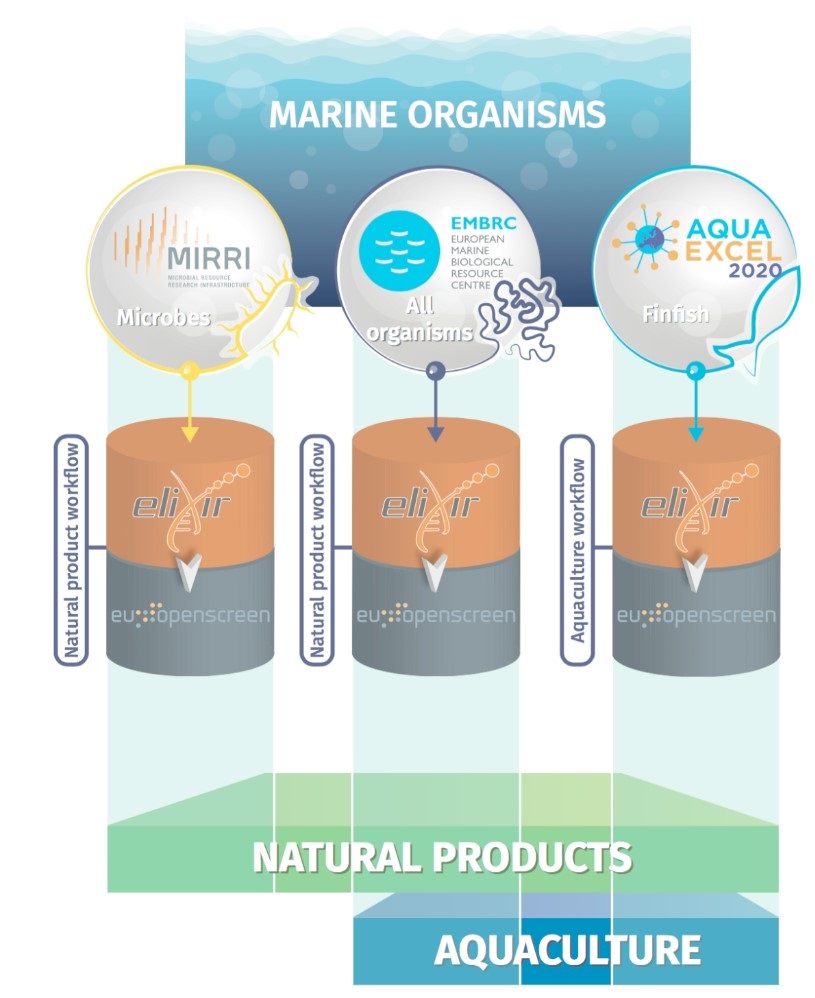EMBRIC Horizon 2020 project promotes new bioeconomy applications related to drug discovery, novel foods and food ingredients, aquaculture selective breeding, bioremediation, cosmetics and bioenergy.
The marine environment accounts for over 90% of the biosphere and harbours a wide biodiversity. Marine organisms have historically been difficult to access and study, but thanks to the recent development of marine laboratories and related biological science Research Infrastructures (RIs) in Europe, a wider range of marine biodiversity can now be examined in greater detail than ever before.
Marine biotechnology is the key to unlocking the potential of the unique biodiversity of marine organisms. It is rooted in basic research bringing together marine biology, microbiology, physiology, toxicology, systems biology, bioinformatics, omics technologies and chemistry.
Immense marine biodiversity remaining largely untapped
The high economic potential of marine biotechnologies remains largely untapped and the development of the marine biotechnology sector is hindered by:
- Operational issues preventing the scientific community from fully exploring marine biological resources;
- Practical and cultural difficulties in connecting science with industry;
- High fragmentation of regional innovation ecosystems in marine biotechnology throughout Europe.
The potential of the oceans is uncontested among experts, but its exploration requires close cooperation and knowledge sharing, a strong focus on sustainability, political commitment and finally, investor and consumer enthusiasm.
A closer collaboration is needed – this is where EMBRIC comes into play

EMBRIC discovery pipelines.
To overcome these barriers and to enable a sustainable use and conservation of marine genetic resources, increased connectivity is needed between RIs and their communities of users, between science and industry, as well as between the RIs and the Research Development and Innovation (RDI) policies in the European maritime regions. Consequently, EMBRIC aims to link biological and social science Research Infrastructures (AQUAEXCEL, ELIXIR, EMBRC, MIRRI, EU-OPENSCREEN, RISIS) and build inter-connectivity along the dimensions of science, industry and policy.
One of the main goals of EMBRIC is to connect the peripheral maritime regions better with the rest of Europe. EMBRIC enables access to biological, analytical and data resources through by creating transdisciplinary ‘discovery pipelines’ – to develop marine products and compounds from biological resources collected by research laboratories affiliated to Research Infrastructures such as MIRRI (microbes and prokaryotes) EMBRC (marine organisms) and AQUAEXCEL (finfish). Further, an online visualization tool is available on the EMBRIC website. These discovery pipelines are accessible through sponsored transnational access and calls for training.
The EMBRIC Transnational Access program includes access to marine organisms, technical and scientific support, open use of the services and platforms as well as hands-on training to use the facilities. EMBRIC increases the interconnectivity of RIs with the industry by federating a community of technology transfer (TT) services, such as:
- Setting up a panel of TT officers representing the different RIs to analyse the innovation ecosystems linked to the different cluster nodes, their territorial embedding as well as the TT practices currently developed or implemented.
- Initiating a company forum on aquaculture and microalgae to have direct links with industrial actors and support the communities with biological and computational resources, maturation of new technologies, knowledge and training.
Creating connections amongst different stakholders: EMBRIC past events
Marine resources are part of local ecosystems – both physical and institutional. Thus, it is essential to join forces with peripheral maritime regions to convince policy makers that marine resources are part of the solution for a sustainable circular bioeconomy:
- Together with the Conference on Peripheral Maritime Regions (CPMR), EMBRIC organized an outreach event at the European Parliament in March 21, 2018. In the focus: marine biotechnology and its potential for a sustainable future. The event succeeded move the blue bioeconomy up on the political agenda.
- On the initiative of EMBRIC, representatives of the regions of Crete, the Algarve, Brittany, Basque Country, Galicia met in mid-September 2018 to discuss how to best foster blue bioeconomy development. The meeting brought academic infrastructures, regional experts and companies together who decided to join forces to map their regional expertise, share best-practice examples and explore late-stage financing instruments on a pan-European level.
New momentum with the updated bioeconomy strategy
The updated EU Bioeconomy Strategy, which was presented at the 22nd of October in Brussels, considers the blue bioeconomy as a cornerstone of the European bioeconomy and has dedicated a specific section to it. With EMBRIC coming to an end in May 31st 2019, it will now focus on:
- reinforcing the long-term sustainability of EMBRIC pipelines, through the involvement of regional authorities and the enlargement of the spectrum of companies using the Infrastructures;
- accelerating the development of blue bio-economy in Europe and increasing the competitiveness of companies in this sector;
- showcasing the added value of establishing synergies between national funds, R&I funds, structural funds and investment funds
- illustrating the value of extending the paradigm of Open Science to Open Innovation.
About EMBRIC
The EMBRIC consortium comprises 29 partners of 4 different types (Academia, Research institutes, non-for-profit organizations and industry). EMBRIC partners are distributed in 8 EU Member states and 2 associated Member states.
This project has received funding from the European Union’s Horizon 2020 research and innovation programme under grant agreement No 654008.
For further information visit EMBRIC website.
Text provided by Amélie Lecornec, EMBRIC scientific and technical manager, Sorbonne Université.


